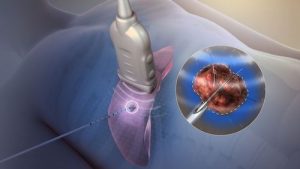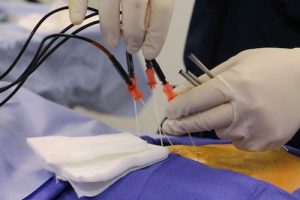Board Certified, New York City Based, Osteopath Specializing in Spine, Pain and Sports Medicine
Radiofrequency Ablation
What is Radiofrequency Ablation?
Radiofrequency ablation is a treatment option that uses radio waves. The radio waves are sent along a needle that is placed on a nerve that is known to be a pathway for pain signals. As the radio waves begin to pulse, the current is sent along the needle and directed onto the nerve. The nerve is “sealed” or cauterized, preventing any further pain signals from making their way to the brain and back down to the injured areas of the body. Radiofrequency ablation offers very few side effects and minimal downtime. A person who has the procedure may be able to resume their regular day to day activities within a few hours of the procedure.

What Conditions Can Radiofrequency Ablation Treat?
Radiofrequency ablation can help a wide variety of health conditions that have to do with nerve pain. Diabetic neuropathy, sciatica, pinched nerves in the neck, back, and hip are just a few of the most common conditions. Individuals who have spinal stenosis may also be able to have their pain relieved using the radiofrequency ablation procedure. This type of treatment works well for patients who suffer from long-term, chronic pain caused by an old injury or a progressive health condition like fibromyalgia, arthritis, or neuropathy. When used with physical therapy and exercise, radiofrequency ablation can be extremely effective at offering long-lasting results.
How Do I Prepare For Radiofrequency Ablation?
If you are on any anticoagulant medication or if you have a blood disorder, a pre-procedure medical clearance will be required from your prescribing physician.
If you have chosen to have local anesthesia there are no requirements to fast before the procedure, and you will be able to leave the surgery center yourself after an observation period. If you have chosen to have for sedation anesthesia (known as MAC), you will need to abstain from food or drink the night before the procedure and up until the time the procedure is completed. You will also need to have someone to pick you up from the procedure and escort you home.
Following the check-in process at the Surgical Center, additional screening measures for procedural safety will be done, these include: Blood pressure, temperature, respiratory rate, pulse, blood oxygen saturation & blood sugar level for diabetics. As x-ray guidance is used, a pregnancy test may be provided for women.
Before the procedure, there will be multiple confirmations of your procedure site and left or right side, or both sides will be confirmed, this is normal.
Radiofrequency Ablation Uses
We are often treating patients with spinal and back pain but ultimately pain can originate or radiate to all parts of the body and its nerves. Since radiofrequency ablation is the burning of nerve endings the treatment can be used throughout the body wherever the pain is being felt.
Besides it being a fairly invasive procedure it is quite painful. Even though it is being done through a needle it can cause quite a bit of pain and discomfort. The procedure is painful and the treatment area can feel discomfort for 2 to 3 weeks after. We rarely ever get to the point of this even being a potential option for our patients. We are strong believers in a more natural and strengthening treatment path versus a more quick and immediate approach.

If you have been recommended or feel radiofrequency ablation is a potential treatment option please contact our office to schedule a consultation to walk through all your options.
What Results Can I Expect From Radiofrequency Ablation?
Radiofrequency Ablation Treatment Process
A single radiofrequency ablation treatment may take 5-30 minutes, but the procedure’s results are expected to last for 6-10 months. The doctor will normally use an X-ray or ultrasound to guide placement of the radiofrequency probe into place so the radio frequency waves can be directed along the surface of the nerve. Before the ablation process starts a small amount of anesthesia is applied for procedural comfort. The patient may feel a tingling or burning sensation during the treatment, but this normally does not last long.
Radiofrequency Ablation Treatment Aftercare
Your vital signs will again be checked, after an observation period you will be discharged. You may experience some post procedure soreness at the injection sites, this is expected, and may last for several days. Apply an ice pack for 15 to 20 minutes up to 3-4 times a day and thsi should noticeably decrease any soreness. You should follow-up within 1 to 2 weeks in the office with Dr Magyar. On the day of the procedure you should not perform any strenuous or aggravating activity, and resume use of your normal pain medication. The next day you may perform up to 50% of the activities you were performing before the procedure. The second day you can do up to 75% of the activity level you were performing. By the third day, you should be able to resume whatever activity you were performing before the procedure.
If there is any substantial increase in pain, fever, weakness, loss of sensation, or bowel and bladder issue, you should go to the nearest emergency room and immediately call the office.
What Are The Side Effects Of Radiofrequency Ablation?
What Are The Costs For Radiofrequency Ablation?
Depending on insurance coverage this may be covered by your plan. We are committed to providing extraordinary care that is still affordable. Payments from most insurance plans are accepted as a non-par provider (i.e. we accept out of network benefits). If health insurance coverage is not accepted or with high deductible plans, alternative payment arrangements can be made depending on the specific circumstances.
Radiofrequency Ablation Philosophy
Being in the heart of New York our patients are very well educated and informed about their problems. Many New Yorkers come into our practice inquiring specifically requesting radiofrequency ablations. While it is certainly a helpful tool in the treatment of pain, it is often unnecessary for many people that come through our doors. In the correct setting, any risks are minimal to the benefit the ablation may provide. In many scenarios, other treatments may provide a better outcome.
Our doctors preach a philosophy of non-surgical, minimally invasive treatments first. Only after ruling out the manual and less invasive treatment options such as osteopathic manipulation or trigger point injections would we present radiofrequency ablation as an option.

